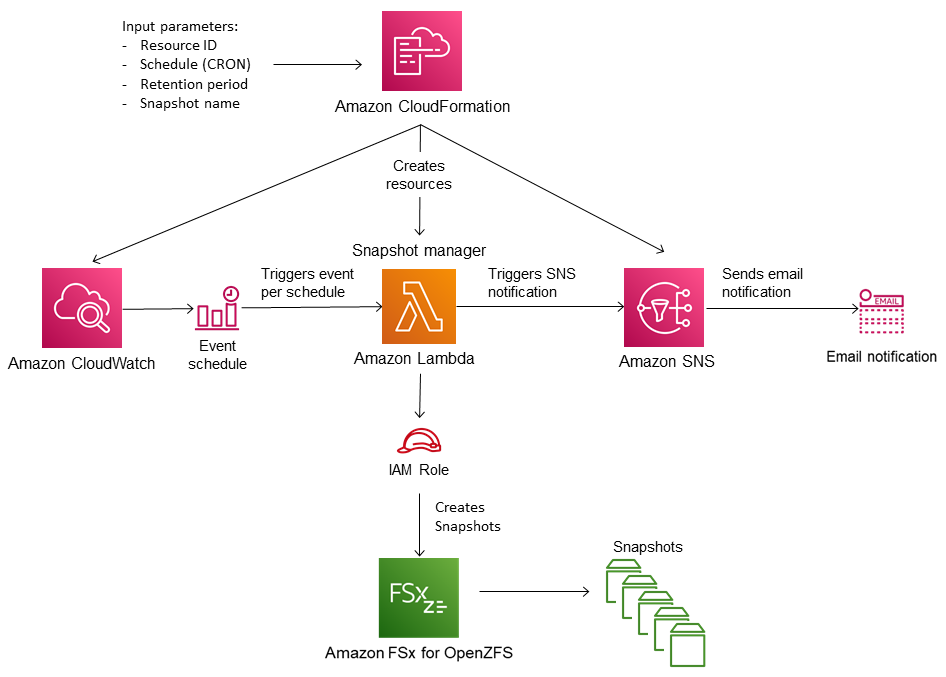Setting up a custom snapshot schedule
You can set up a automated custom snapshot schedule for FSx for OpenZFS volumes using the resources and configuration template provided in this topic. The custom snapshot scheduling solution performs user-initiated snapshots of your Amazon FSx volumes on a custom schedule that you define. For example, you can configure a custom schedule to take a snapshot every hour and automatically delete snapshots that are older than two days.
For more information on CRON schedule patterns, see Schedule expressions for rules in the Amazon CloudWatch Events User Guide.
Architecture overview
Deploying this solution builds the following resources in the Amazon Web Services Cloud:

The diagram illustrates the following custom snapshot schedule workflow:
-
The solution Amazon CloudFormation template deploys an CloudWatch Event, an Amazon Lambda function, an Amazon Simple Notification Service (Amazon SNS) queue, and an IAM role. The IAM role gives the Lambda function permission to invoke the necessary Amazon FSx API operations.
-
The CloudWatch event runs on a schedule you define as a CRON pattern, during the initial deployment. This event invokes the solution’s snapshot manager Lambda function that invokes the Amazon FSx
CreateSnapshotAPI operation to initiate a snapshot. -
The snapshot manager retrieves a list of existing user-initiated snapshots for the specified volume using
DescribeSnapshots. It then deletes snapshots older than the retention period, which you specify during the initial deployment. -
The snapshot manager sends a notification message to the Amazon SNS queue on a successful snapshot if you choose the option to be notified during the initial deployment. A notification is always sent in the event of a failure.
Required permissions
The following permissions are required to use the custom snapshot schedule Amazon CloudFormation template:
AWSCloudFormationFullAccessAmazonS3FullAccessAmazonEventBridgeFullAccessIAMFullAccessAmazonSNSFullAccessAWSKeyManagementServicePowerUserAWSLambda_FullAccess
Amazon CloudFormation template
This solution uses Amazon CloudFormation to automate the deployment of the Amazon FSx custom snapshot scheduling
solution. To use this solution, download the fsx-openzfs-scheduled-snapshot.template
Automated deployment
The following procedure configures and deploys this custom snapshot scheduling solution. It takes about five minutes to deploy. Before you start, you must have the ID of a volume on an Amazon FSx file system running in an Amazon Virtual Private Cloud (Amazon VPC) in your Amazon account. For more information on creating these resources, see Creating an Amazon FSx for OpenZFS volume.
Note
Implementing this solution incurs billing for the associated Amazon services. For more information, see the pricing details pages for those services.
To launch the custom snapshot solution stack
-
Download the fsx-openzfs-scheduled-snapshot.template
Amazon CloudFormation template. For more information on creating an Amazon CloudFormation stack, see Creating a stack on the Amazon CloudFormation console in the Amazon CloudFormation User Guide. Note
By default, this template launches in the US East (N. Virginia) Amazon Web Services Region. Amazon FSx for OpenZFS is currently only available in specific Amazon Web Services Regions. You must launch this solution in an Amazon Web Services Region where FSx for OpenZFS is available. For more information, see Amazon FSx endpoints and quotas in the Amazon Web Services General Reference.
-
For Parameters, review the parameters for the template and modify them for the needs of your file system volumes. This solution uses the following default values.
Parameter Default Description FSx for OpenZFS resource ID No default value The file system ID or volume ID on which the snapshot schedule will apply. If you provide a file system ID, the schedule will take snapshots of all volumes within that file system. CRON schedule pattern for snapshots 0 0/6 * * ? *
[Every 6 hours]
The schedule to run the CloudWatch event, triggering a new snapshot and deleting old snapshots outside of the retention period. Snapshot retention (days) 7 The number of days to keep user-initiated snapshots. The Lambda function deletes user-initiated snapshots older than this number of days. Name for snapshots User-scheduled_snapshot The name for these snapshots, which appears in the Snapshot Name column of the Amazon FSx Management Console. Snapshot Notification Yes Choose whether to be notified when snapshots are successfully initiated. A notification is always sent if there's an error. Email address No default value The email address to use in subscribing to the SNS notifications. -
Choose Next.
-
For Options, choose Next.
-
For Review, review and confirm the settings. Select the check box acknowledging that the template creates IAM resources.
-
Choose Create to deploy the stack.
You can view the status of the stack in the Amazon CloudFormation console in the Status column. You should see a status of CREATE_COMPLETE in about five minutes.
Additional options
You can use the Lambda function created by this solution to perform custom scheduled snapshots
of more than one FSx for OpenZFS volume. The volume ID is passed to the Amazon FSx function in the
input JSON for the CloudWatch event. The default JSON passed to the Lambda function is as follows, where
the values for VolumeId and SuccessNotification are passed from the
parameters specified when launching the Amazon CloudFormation stack.
{ "start-snapshot": "true", "purge-snapshots": "true", "volume-id": "${VolumeId}", "notify_on_success": "${SuccessNotification}" }
To schedule snapshots for an additional FSx for OpenZFS volume, create another CloudWatch event rule. You
do so using the Schedule event source, with the Lambda function created by this solution as the
target. Choose Constant (JSON text) under Configure
Input. For the JSON input, simply substitute the volume ID of the FSx for OpenZFS
volume to back up in place of ${VolumeId}. Also, substitute either
Yes or No in place of ${SuccessNotification} in the JSON
above.
Any additional CloudWatch Event rules you create manually aren't part of the Amazon CloudFormation stack for the Amazon FSx custom scheduled snapshot solution. Thus, they aren't removed if you delete the stack.